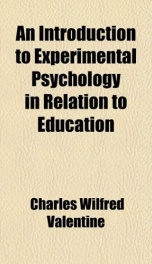an introduction to experimental psychology in relation to education

Purchase of this book includes free trial access to www.million-books.com where you can read more than a million books for free. This is an OCR edition with typos. Excerpt from book: CHAPTER VII. ON THE VALUE OF A MAP. Experiment XVII. For this experiment the private student needs the assistance of a friend who will act as experimenter while he is the subject. Below are given two pieces of imaginary " history." Piece A is to be read out by the experimenter to the subject (or to a class). Piece A is illustrated by a map, to which the operator must point at the appropriate times while this piece is being read out. The exact time taken by the lesson should be noted by the experimenter. The piece should be read only once, then the subject (or class) should write down the answers to the questions given below, which should be read out by the experimenter. Subsequently Piece B should be read out, at as nearly the same rate as possible to that of Piece A. If it is found that it is finished in less time than was taken to read Piece A (as is not unlikely owing to the use of the map with Piece A) a portion can be re-read until the time is completed. Now Questions B must be answered. Historical Piece A. In the first year of the reign of William X., of Zamboo, A.d. 2100, a revolt occurred among his subjects living among the hills of Banah. In these almost inaccessible heights the king's civilised troops at first could do little to suppress the revolt. Eventually, however, the greatest leader of the day, General Wodam, took command of the army, and set out with a large force northwards from Kali on the Eiver Tarn. This river flows near the base of the highest hills in the Eanah range, and its valley formed an excellent route for the march. At Sulby, quite by the hills, they were surprised to find a large band of the rebels holding the pass up to the mountain villages. General Wodam, however, leaving a force of 500 men to hold the enemy in check a...
Info about the book
Author:
Series:
Unknown
ISBN:
1172285829
Rating:
3/5 (1)Your rating:
0/5
Languge:
English
Users who have this book
Users who want this book
What readers are saying
What do you think? Write your own comment on this book!
write a commentif you like an introduction to experimental psychology in relation to education try:
Other books by this author
Do you want to exchange books? It’s EASY!
Get registered and find other users who want to give their favourite books to good hands!


